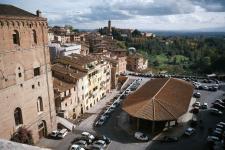|
Beaugers Lubo |
Manufactured or assembled in France from 1941 to 1952.
Index of rarity in France: Rare (among non-specialized garage sales)
Inventory number: 16042
See the complete technical specifications
Chronology of cameras Beaugers
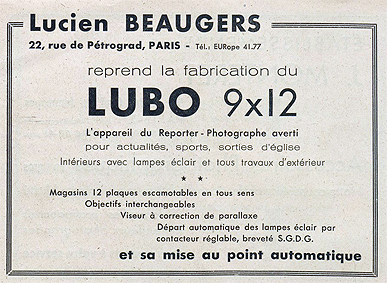 Lucien Beaugers was a photographer who built a reportage camera from 1941 to 1952, with a hiatus during part of the war. Bernard Vial provided its history and description in a four-page article in "Photo-Ciné-Son Occasion," attributing it with a certain commercial success, while McKeown lists a production of 20 to 25 units, which does not seem realistic.
Lucien Beaugers was a photographer who built a reportage camera from 1941 to 1952, with a hiatus during part of the war. Bernard Vial provided its history and description in a four-page article in "Photo-Ciné-Son Occasion," attributing it with a certain commercial success, while McKeown lists a production of 20 to 25 units, which does not seem realistic.
Lucien Beaugers also manufactured a studio camera, although it doesn't seem to be well-known. He also patented a flash that could accommodate six bulbs.
In May 1949, the Grenier catalog offered the Microflash Lubo, described as "compact and highly effective." It used PF 14 and PF 25 bulbs and a flat 4.5-volt battery. It fit inside a box measuring 85 x 85 x 110 mm and cost 1885 francs at the time.
In 1952, Lucien Beaugers sold his workshop to Henri Trémaud, the son of the Commercial Director at Berthiot, representing Lévêque cameras and Royer cameras.
The uniqueness of the Lubo camera is that the front facade can tilt, allowing for precise focusing using an integrated frosted glass screen when in this position. Manufactured in an artisanal manner for about a decade, there are numerous variants, although they may be challenging to catalog.
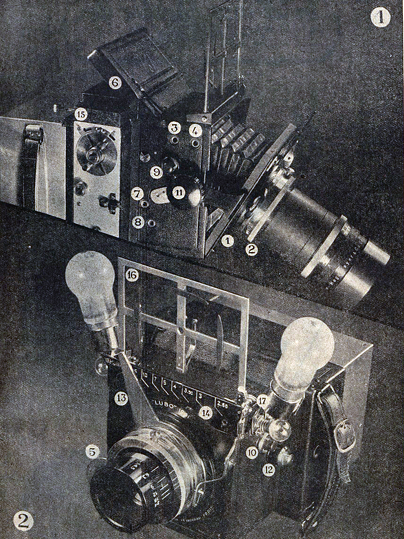 LUBO REPORTAGE CAMERA (presentation in Le Photographe, June 1942)
LUBO REPORTAGE CAMERA (presentation in Le Photographe, June 1942)
Technical Information
The LUBO, of which we provide a photographic reproduction, is specially designed for reportage photography and offers the following features, highly appreciated by reportage specialists.
In photograph 1, you can see the LUBO with a 300 mm telephoto lens in its focused position. Photograph 2 shows the LUBO in its shooting position. The change of position occurs automatically in half a second. The camera can accommodate all lenses from 100 mm to 400 mm.
1) Helical mount integrated with the camera body.
2) Lens support that instantly adapts to the mount.
3-4) Sockets for the flash lamp holder (one lamp and its reflector on each side of the camera), which can be synchronized with a lens shutter or the plate shutter as desired.
5) Ring for controlling the helical mount.
6) Cap with automatic opening and closing for focusing. The fixed frosted glass is inside the camera.
7-8) The battery used to fire the flash lamps is inside the camera; however, these two sockets allow for a stronger battery for speeds exceeding 1/1000 second.
9-10) Buttons for triggering each flash lamp separately or two lamps together.
11-12) Buttons for the tilt mechanism, with double locking and automatic opening and closing of the upper cap.
13-14) Reading index and double, mobile, and reversible graduated ruler calibrated for two lenses in use.
15) Unique and adjustable device for firing the flash lamps directly on the curtain, from 1/50 second to 1/2000 second.
16) Viewfinder with adjustable sliders for different focal lengths and automatic parallax correction.
17) Flash lamp holder with indicator bulb.
The LUBO is the most advanced professional camera. It is currently manufactured in the 9 x 12 format. Delivery time: 3 months from the date of the order. Limited series.
LUCIEN BEAUGERS, 22 rue de Pétrograd, Paris (8th).
The Lubo reportage camera featured on this page is an early model. A lever on the left side facilitates the tilting motion, which opens the cover, allowing for viewing through the ground glass.
Focusing is achieved through a large helicoid integrated with the camera. This model also includes an automatic parallax correction system, thanks to a cam and lever mechanism controlled by the focusing.
The large sports viewfinder, lacking an eyepiece, may result in somewhat approximate framing, making the parallax correction seem somewhat unnecessary.
The lenses are interchangeable, facilitated by a bayonet system secured with a knurled screw. There are two nuts with a standard thread, one at the bottom and one on the side, designed to accommodate the Hexaflash flash unit. Flash synchronization is done through a large two-pin socket on each side.
The "Balmelle" cloth shutter allows for speed adjustment by spring tension (8 positions), slit width (from 1 to 8 cm), and a regulator for the slow and fast range.

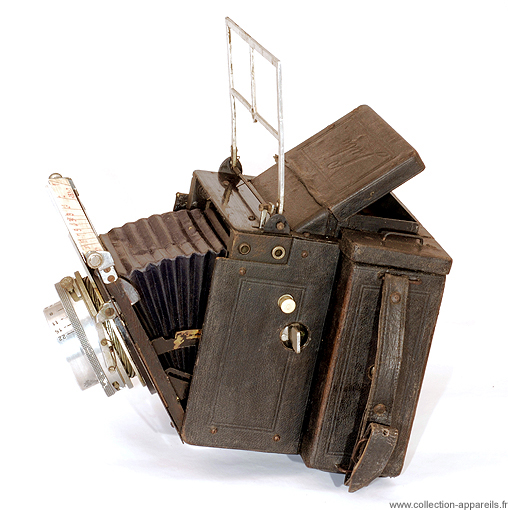
Shifted position enabling focusing. The lever for maneuvering the shift is visible. The white button enables open flash, with the socket above.
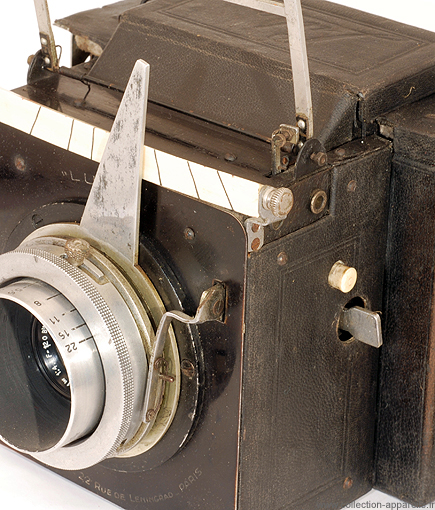
Detail of the parallax correction mechanism. The triangular piece carries distance scales for estimating focus. (Here for 120 and 200 mm).
Interesting links or bibliography :
Add a link or element of bibliography, a picture taken with this camera, a picture of box or an ads about this camera
Your photos taken with the same camera:
Cameras from Ebay France (Beaugers) (Uploaded each 3 hours)







